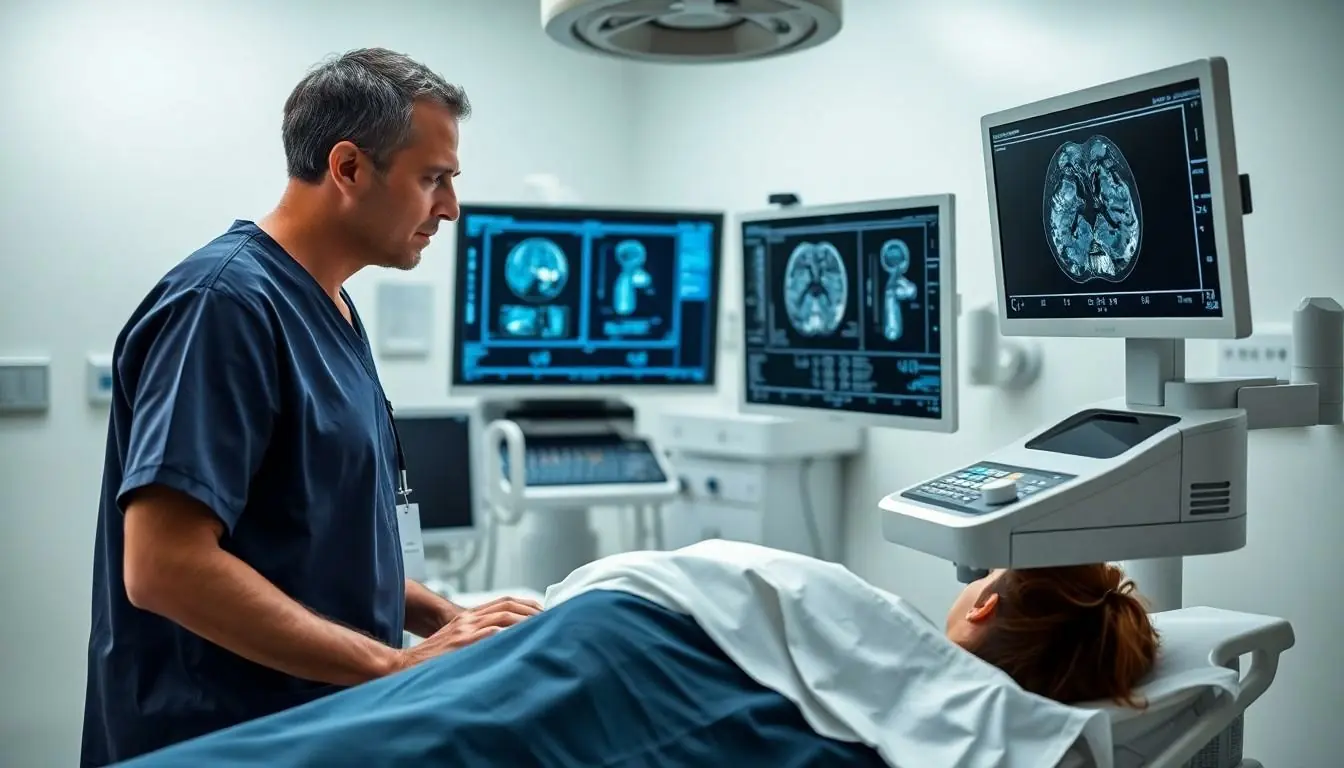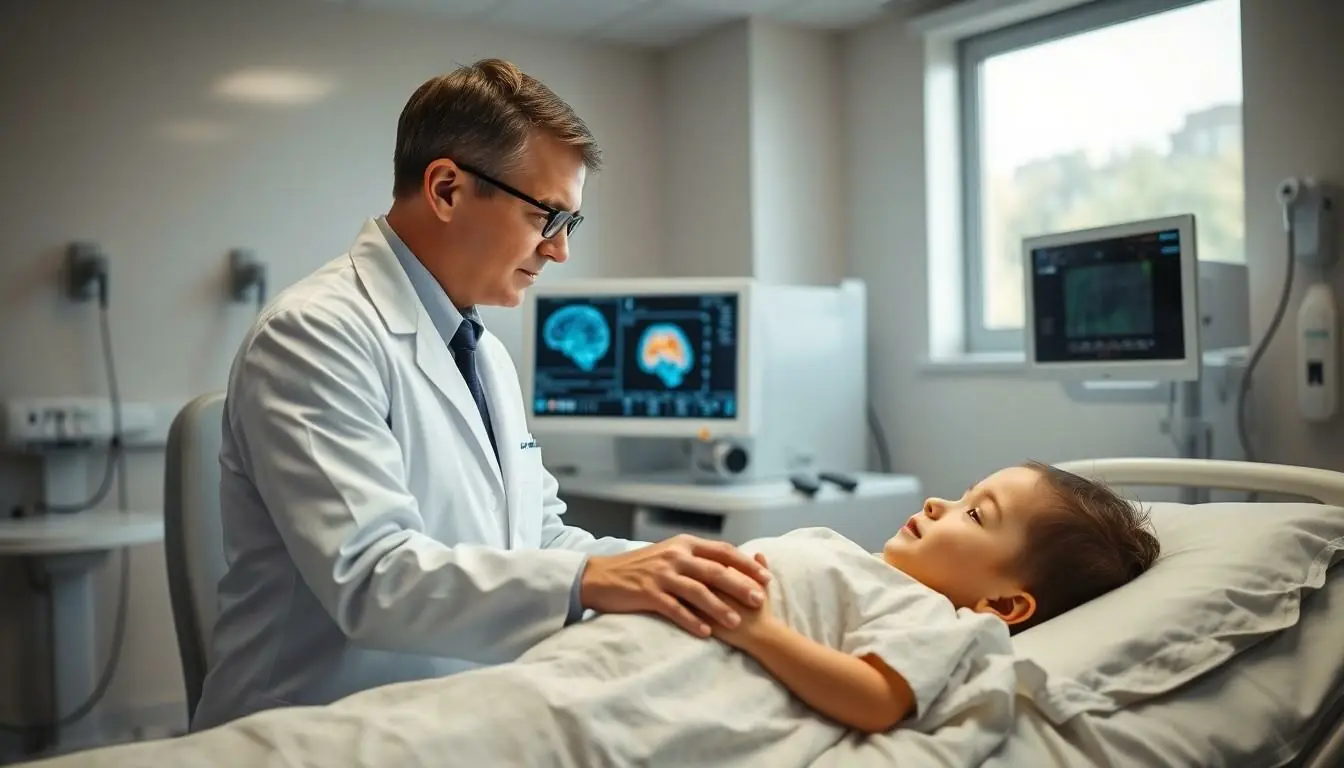Imagine a world where diagnosing brain conditions doesn’t involve a game of “guess what’s in there.” Enter neuro ultrasound tech, the superhero of medical imaging. It’s like having a trusty sidekick that uses sound waves to peek inside the noggin without any of that pesky radiation.
Table of Contents
ToggleOverview of Neuro Ultrasound Tech
Neuro ultrasound technology utilizes high-frequency sound waves to create images of the brain and nervous system. This non-invasive technique enhances real-time visualization, allowing healthcare professionals to assess conditions like strokes, tumors, and other neurological disorders. Sound waves penetrate body tissues without harming them, offering a safer alternative to traditional imaging methods that rely on radiation.
This technology stands out due to its accessibility and cost-effectiveness. Many medical facilities can integrate neuro ultrasound equipment without extensive modifications to their current setups. Portability further enhances its appeal, enabling bedside examinations and point-of-care diagnostics.
Numerous studies show that neuro ultrasound achieves comparable results to other imaging techniques. Specific conditions, such as intracranial hemorrhages, can be effectively diagnosed through neuro ultrasound. Clinicians benefit from immediate results, facilitating quicker decision-making and treatment.
Training remains crucial for optimal usage of neuro ultrasound technology. Practitioners must be well-versed in interpreting the images produced. As skills improve, patient outcomes enhance due to more accurate diagnoses and timely interventions.
Research continues to explore new applications for neuro ultrasound. Emerging evidence suggests its effectiveness in monitoring brain injuries and guiding minimally invasive procedures. As the field advances, healthcare providers may discover additional uses that further integrate this technology into standard medical practice.
Benefits of Neuro Ultrasound Tech

Neuro ultrasound technology offers several key advantages that enhance medical imaging practices. Its non-invasive nature and ability to provide real-time monitoring streamline the diagnostic process.
Non-Invasive Imaging
Non-invasive imaging represents a profound benefit of neuro ultrasound technology. Unlike traditional imaging techniques that often require more complex procedures, neuro ultrasound avoids exposure to radiation. Patients experience less discomfort since the process involves simply applying a transducer to the head. This characteristic makes it particularly suitable for vulnerable populations, including children and pregnant individuals. Similarly, the minimal risks associated with neuro ultrasound encourage broader usage, promoting early detection of brain conditions. As a result, healthcare providers can move forward with accurate diagnoses without compromising patient safety.
Real-Time Monitoring
Real-time monitoring stands out among the benefits of neuro ultrasound tech. Healthcare professionals can visualize brain activity and conditions instantly, allowing for immediate assessment of stroke and other neurological issues. This capability results in quicker decision-making regarding patients’ treatment plans. During critical moments, such as assessing brain injuries, real-time data can significantly impact patient outcomes. The immediacy of results also means that clinicians can adjust interventions on the spot, enhancing the overall care process. Consequently, neuro ultrasound not only supports timely diagnoses but also contributes to a proactive approach in managing neurological health.
Applications in Medical Practice
Neuro ultrasound technology plays a pivotal role in modern medical practice. Its advanced capabilities enhance diagnostic processes and treatment efficiency across various neurological conditions.
Stroke Diagnosis
Neuro ultrasound facilitates rapid stroke diagnosis by allowing immediate visualization of blood flow and brain activity. This method proves crucial in identifying ischemic strokes, where timely intervention significantly improves patient outcomes. Clinicians can utilize Doppler ultrasound to assess cerebral blood flow and detect blockages. In scenarios where every minute counts, neuro ultrasound provides guidance for treatment decisions. Several studies confirm its effectiveness in comparison with traditional imaging methods, establishing it as a reliable tool in emergency settings.
Brain Tumor Assessment
Neuro ultrasound contributes to brain tumor assessment by enabling clinicians to evaluate tumor size and location with precision. This imaging technique offers real-time monitoring, which aids in tracking growth and response to treatment. Its non-invasive nature minimizes risks for patients, making it suitable for those requiring frequent assessments. Furthermore, neuro ultrasound assists in differentiating between tumor types based on echo pattern characteristics. With ongoing research, its application in tumor characterization continues to expand, emphasizing its importance in radiation-free diagnostics.
Limitations and Challenges
Neuro ultrasound technology, while promising, faces limitations and challenges that impact its overall effectiveness. Understanding these challenges is crucial for healthcare professionals.
Technical Constraints
Technical constraints include depth limitation of ultrasound penetration in brain tissue. High-frequency sound waves have a limited ability to reach deeper structures, which might result in incomplete imaging for certain patients. Signal attenuation can affect quality, especially in patients with increased skull thickness. Furthermore, the equipment requires considerable calibration and maintenance, which can sometimes inhibit consistent usage across various clinical settings.
Interpretation Variability
Interpretation variability arises from the subjective nature of ultrasound imaging. Different practitioners may interpret images differently, leading to potential misdiagnosis. Lack of standardized protocols for image acquisition and analysis can exacerbate this issue. Moreover, the experience level of the operator impacts image evaluation and diagnostic accuracy. Training and continuing education are essential to minimize interpretation variability and enhance patient care outcomes.
Future Prospects of Neuro Ultrasound Tech
Emerging research suggests promising advancements in neuro ultrasound technology. Scientists explore applications beyond traditional diagnostics, including real-time monitoring of brain injuries. Innovations in equipment design enhance imaging quality, potentially improving detection rates of neurological conditions.
Integrating artificial intelligence into neuro ultrasound processing is underway. This integration could automate image analysis, leading to more consistent interpretations and faster diagnoses. AI algorithms can identify anomalies in brain structures, supporting practitioners in making informed decisions.
Expanding training programs for healthcare providers is vital. Specialized training ensures practitioners can effectively utilize neuro ultrasound tools, minimizing interpretation variability. As awareness of the benefits grows, more medical institutions are adopting neuro ultrasound in routine clinical settings.
Collaborative research initiatives between institutions enhance the development of best practices. These collaborations aim to establish standardized protocols for image acquisition and analysis. Such efforts may significantly improve the reliability of neuro ultrasound as a diagnostic tool.
Focusing on regulatory advancements is crucial for widespread adoption. Developing guidelines that address safety and efficacy can foster confidence among practitioners and patients alike. As institutions embrace neuro ultrasound technology, patient care could see considerable improvements.
Overall, commitment to research, training, and innovation shapes the future landscape of neuro ultrasound tech. Opportunities abound for refining existing applications and discovering new ones. Continued efforts in this field promise to solidify neuro ultrasound’s role in modern medicine.
Neuro ultrasound technology represents a significant leap in medical imaging for brain conditions. Its non-invasive approach and real-time monitoring capabilities enhance patient care and decision-making. As this technology evolves with advancements in artificial intelligence and standardized protocols, its integration into clinical practice will likely expand. Continued research and training will be crucial in overcoming current challenges and maximizing its potential. Embracing neuro ultrasound can lead to improved diagnostics and treatment, ultimately benefiting patients and healthcare providers alike.





